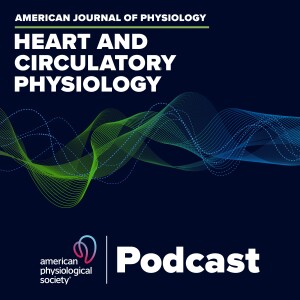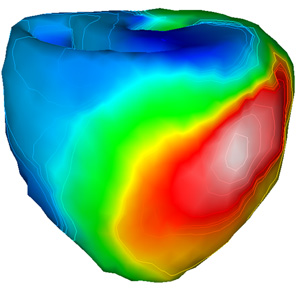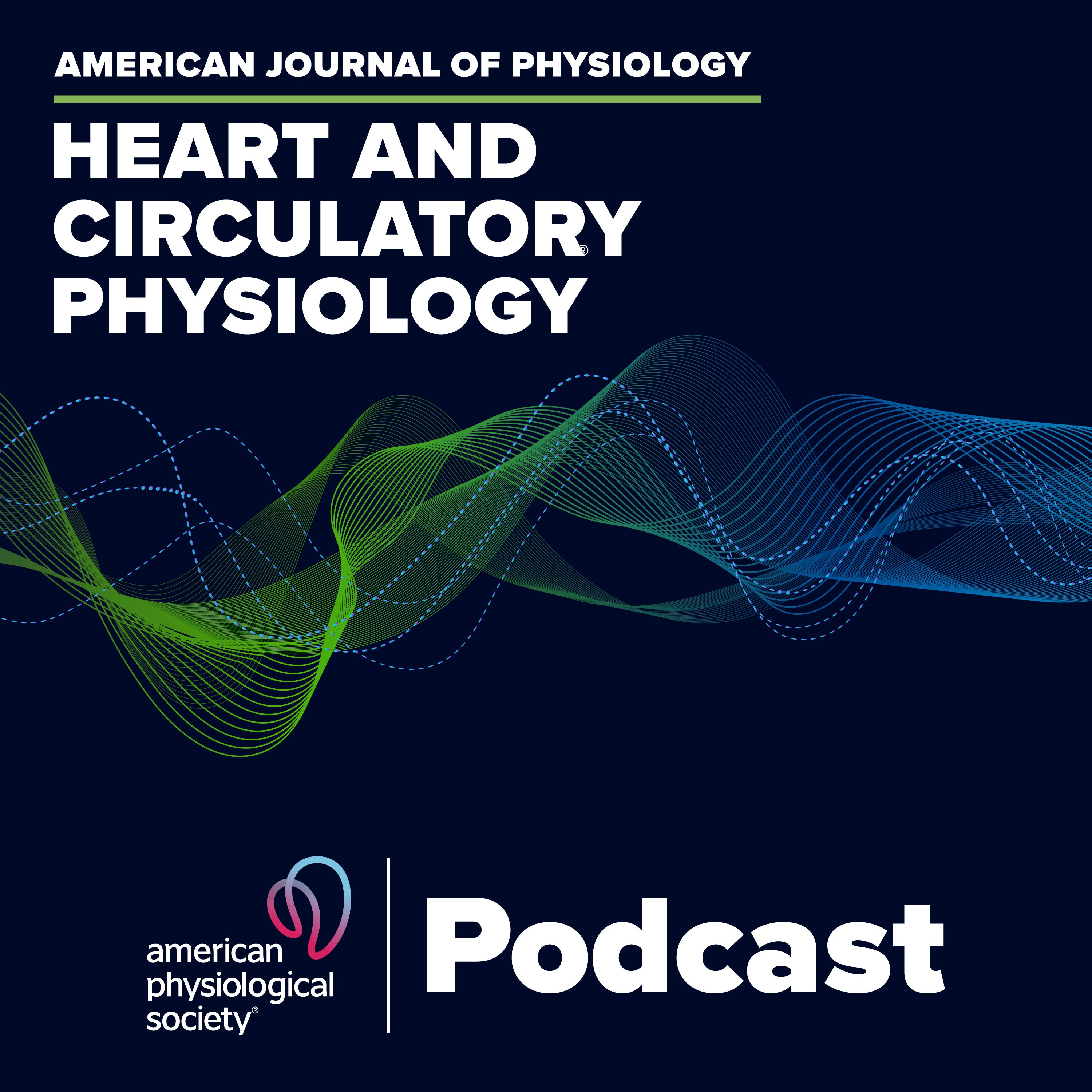Episodes

Tuesday Aug 30, 2016
AngII and Aging-Induced Endothelial Dysfunction
Tuesday Aug 30, 2016
Tuesday Aug 30, 2016
Aging, as we all know, is unavoidable and leads to an increased risk for vascular dysfunction and cardiovascular pathologies. So what are the mechanisms responsible for aging-induced vascular dysfunction? That’s just what Flavahan et al set out to investigate in their latest work in AJP-Heart and Circ. Listen as Editor in Chief Dr. Irving H. Zucker (University of Nebraska Medical Center) interviews lead author Nick Flavahan (Johns Hopkins University) and content expert Edward Lakatta (National Institute on Aging, National Institutes of Health) about Flavahan’s work, which builds on previous studies by Lakatta. Chronic in vivo inhibition of angiotensin activity protects endothelial function, but is it due to blockade of the systemic Renin-Agiotensin System (RAS) or the local vascular angiotensin system? What role do changes in anti-oxidant scavenging mechanisms play in endothelial dysfunction associated with aging? How do flow-mediated dilation and changes in angiotensin receptor expression fit into the big picture of aging? Listen and find out.
Sheila Flavahan, Fumin Chang, Nicholas A. Flavahan Local Renin-Angiotensin System Mediates Endothelial Dilator Dysfunction in Aging Arteries Am J Physiol Heart Circ Physiol, published July 15, 2016. DOI: 10.1152/ajpheart.00422.2016

Tuesday Aug 16, 2016
Sympathetic Reactivity and Family History of Hypertension
Tuesday Aug 16, 2016
Tuesday Aug 16, 2016
How does family history of hypertension contribute to sympathetic neural control of blood pressure, and what role does mental stress play in blood pressure regulation? The latest work by Fonkue et al seeks to answer these very questions. Listen as Consulting Editor Nisha Charkoudian (U.S. Army Research Institute of Environmental Medicine) interviews lead author Jason Carter (Michigan Technological University) and content expert Megan Wenner (University of Delaware) about the study by Carter and colleagues, which used microneurography to measure muscle sympathetic nerve activity (MSNA) during an acute bout of mental stress (performing mental math) in both women and men with, and without, a family history of hypertension. Can evaluations of larger groups over several years help determine if the sympathetic nervous system plays an essential role in the development of hypertension in those with a family history of the disease? Listen and find out.
Ida T. Fonkoue, Min Wang, Jason R. Carter Sympathetic neural reactivity to mental stress in offspring of hypertensive parents: 20 years revisited Am J Physiol Heart Circ Physiol, published July 1, 2016. DOI: 10.1152/ajpheart.00378.2016

Wednesday Aug 03, 2016
Vascular Health After Preeclampsia
Wednesday Aug 03, 2016
Wednesday Aug 03, 2016
What is the mechanism behind the increased risk for cardiovascular and renal diseases in women who have previously suffered from early-onset preeclampsia? Listen as Associate Editor Robert Hester (University of Mississippi Medical Center) interviews lead author Anne Marijn van der Graaf (University of Groningen Medical Center) and content expert Ira Bernstein (University of Vermont Medical Center) about the clinical study by van der Graaf and colleagues, which compared the arterial stiffness of healthy women with a history of preeclamptic pregnancy to healthy women with no preeclamptic pregnancy history after low sodium and high sodium diets. Were formerly preeclamptic women able to adjust their arterial stiffness after eating a low sodium diet? What is the role of vessel wall function and the glycocalyx as markers of vascular stiffness? Listen and find out.
Anne Marijn van der Graaf, Nina D. Paauw, Tsjitske J. Toering, Martin Feelisch, Marijke M. Faas, Thomas R. Sutton, Magdalena Minnion, Joop D. Lefrandt, Sicco A. Scherjon, Arie Franx, Gerjan Navis, A. Titia Lely Impaired sodium-dependent adaptation of arterial stiffness in formerly preeclamptic women: the RETAP-vascular study Am J Physiol Heart Circ Physiol, published June 1, 2016. DOI: 10.1152/ajpheart.00010.2016

Monday Jul 25, 2016
Acetylation Control of Energy Metabolism in Newborn Hearts
Monday Jul 25, 2016
Monday Jul 25, 2016
How well do we understand the post-translational molecular mechanisms regulating changes in metabolism in the newborn heart? This podcast seeks the answer, as Associate Editor Ajay Shah (King’s College London, British Heart Foundation Centre of Excellence) interviews lead author Gary Lopaschuk (University of Alberta) and content expert Luc Bertrand (Université catholique de Louvain) about the work by Fukushima et al, which found rapid acetylation of a number of fatty acid oxidative enzymes, and increased fatty acid oxidation activity, in the newborn rabbit heart. Why is increased expression of mitochondrial acetyltransferase GCN5L1 important in the changes observed by Lopaschuk and colleagues? Could this be a “master regulator” of protein acetylation? Listen and find out.
Arata Fukushima, Osama Abo Alrob, Liyan Zhang, Cory S Wagg, Tariq Altamimi, Sonia Rawat, Ivan M. Rebeyka, Paul F. Kantor, Gary D. Lopaschuk Acetylation and Succinylation Contribute to Maturational Alterations in Energy Metabolism in the Newborn Heart Am J Physiol Heart Circ Physiol, published June 3, 2016. DOI: 10.1152/ajpheart.00900.2015

Thursday Jul 21, 2016
Chronic Vagal Nerve Stimulation in Stroke-Prone SHR
Thursday Jul 21, 2016
Thursday Jul 21, 2016
Can restoring parasympathetic nerve activity in patients with primary hypertension prevent cardiovascular end organ damage? In this podcast Associate Editor Debra Diz (Wake Forest University School of Medicine) interviews lead author Harald Stauss (University of Iowa) and content expert Douglas Martin (University of South Dakota) about the study by Chapleau et al. Referred to as a “a technological tour de force” that combined chronic vagal nerve stimulation, chronic telemetric blood pressure measurements, and in vivo imaging of the long posterior ciliary artery (LPCA) using the slit lamp approach to assess endothelial function, the authors found that endothelial function improved, without changes in blood pressure. Does this approach have the potential to interrupt the pathway between blood pressure and end organ damage, when lowering blood pressure could lead to adverse clinical ramifications in elderly fall risk patients, for example? Listen and learn.
Mark W. Chapleau, Diane L Rotella, John J Reho, Kamal Rahmouni, Harald M. Stauss Chronic Vagal Nerve Stimulation Prevents High-Salt Diet-Induced Endothelial Dysfunction and Aortic Stiffening in Stroke-Prone Spontaneously Hypertensive Rats Am J Physiol Heart Circ Physiol, published May 20, 2016. DOI: 10.1152/ajpheart.00043.2016

Wednesday Jul 20, 2016
Hypothermia/Rewarming Disrupts E-C Coupling
Wednesday Jul 20, 2016
Wednesday Jul 20, 2016
What is the connection between Tromso, Norway, hypothermia, rewarming, heart failure…and AJP-Heart and Circ? Listen to this fascinating new podcast as Associate Editor Leon De Windt (Cardiovascular Research Institute Maastricht) interviews lead author Gary Sieck (Mayo Clinic) and content expert Jolanda van der Velden (VU University Medical Center Amsterdam) about the intriguing and entirely unique work by Schaible at al, which explores how to protect the heart during rewarming after hypothermia. Whatever the cause of hypothermia—falling into a fjord, skiing accident—inadequate rewarming at a trauma center and/or restarting the heart in the field by first responders can both lead to heart failure. Listen as we discuss how hypothermia can inhibit the SERCA pump, as well as affect the sodium-calcium exchanger, slowing the clearance of calcium. Is it possible for a hypothermic person in asystole, if CPR is administered to restore circulation, to later be rewarmed and survive without any deficits or long-term side effects? Listen and find out.
Niccole Schaible, Young Soo Han, Thuy Hoang, Grace Arteaga, Torkjel Tveita, Gary Sieck Hypothermia/rewarming disrupts excitation-contraction coupling in cardiomyocytes Am J Physiol Heart Circ Physiol, published June 1, 2016. DOI: 10.1152/ajpheart.00840.2015

Monday Jul 11, 2016
Purinergic Dysregulation in Pulmonary Hypertension
Monday Jul 11, 2016
Monday Jul 11, 2016
What role do circulating nucleotides play in the pathobiology of pulmonary arterial hypertension (PAH)? In this new podcast Associate Editor Robert Hester (University of Mississippi Medical Center) interviews lead author Scott Visovatti (University of Michigan) and content expert Nikki Jernigan (University of New Mexico Health Sciences Center) about the clinically important work by Visovatti and colleagues investigating whether CD39—an extracellular nucleotidase responsible for the dephosphorylation of ATP—could be a key trigger for idiopathic PAH. By first investigating human blood and tissue samples of pulmonary arterial hypertension patients, followed by data from a unique CD39 knockout hypoxic mouse model, Visovatti and co-authors gained valuable insight into the PAH phenotype. What two “rescue approaches” did the authors use to lower right ventricular and pulmonary pressures in the CD39 mouse model? Listen and find out.
Scott H Visovatti, Matthew C Hyman, Sascha N Goonewardena, Anuli C. Anyanwu, Yogendra Kanthi, Patrick Robichaud, Jintao Wang, Danica Petrovic-Djergovic, Rahul Rattan, Charles F. Burant, David J Pinsky Purinergic dysregulation in pulmonary hypertension Am J Physiol Heart Circ Physiol, published May 20, 2016. DOI: 10.1152/ajpheart.00572.2015

Tuesday Jun 07, 2016
Particulate Matter Induced Vascular Insulin Resistance
Tuesday Jun 07, 2016
Tuesday Jun 07, 2016
How are diet-independent insulin resistance and defects in endothelial progenitor cell mobilization altered by particulate matter exposure? Find out by listening to this engaging podcast as Guest Editor Loren Wold (The Ohio State University) interviews lead author Petra Haberzettl (University of Louisville) and content expert Timothy Nurkiewicz (West Virginia University) about the recent study by Haberzettl et al published as part of our Call for Papers on Cardiovascular Responses to Environmental Stress. Haberzettl and co-authors used a mouse model to investigate exposure to fine particulate matter, altered sensitivity of blood vessels, and an inflammatory pathway. What “chicken and egg” problem does NOS uncoupling and oxidative stress pose, related to decreased insulin sensitivity via Akt? Does this work challenge the current literature to look beyond cytokines and interleukin-mediated processes to endothelial progenitor cells in the bone marrow? Listen and learn.
Petra Haberzettl, James P. McCracken, Aruni Bhatnagar, Daniel J. Conklin Insulin sensitizers prevent fine particulate matter-induced vascular insulin resistance and changes in endothelial progenitor cell homeostasis Am J Physiol Heart Circ Physiol, published June 1, 2016. DOI: 10.1152/ajpheart.00369.2015

Wednesday Jun 01, 2016
Effects of Age and Estrogen on Cerebrovascular Function
Wednesday Jun 01, 2016
Wednesday Jun 01, 2016
Does aging enhance the deleterious effects of exogenous estrogen in the female cerebrovasculature? In this engaging new podcast, Guest Editor Akos Koller (New York Medical College, Valhalla, and University of Physical Education, Budapest) interviews lead author John Stallone (Texas A & M University) and content expert Ines Drenjancevic (University of Osijek, Croatia) about the intriguing new work by Deer et al, which studied the interplay of vascular prostanoids, estrogen, and aging in small cerebral arteries. Why did the authors choose vasopressin to study the reactivity of the cerebral vasculature? How does the uncoupling of nitric oxide synthase to produce oxygen free radicals relate to aging? How does aging convert estrogen from a beneficial to a deleterious hormone? Listen and find out.
Rachel R. Deer, John N. Stallone Effects of estrogen on cerebrovascular function: age-dependent shifts from beneficial to detrimental in small cerebral arteries of the rat Am J Physiol Heart Circ Physiol, published May 15, 2016. DOI: 10.1152/ajpheart.00645.2015.

Tuesday May 31, 2016
Diastolic Dysfunction in the Hypertensive mRen2 Rat
Tuesday May 31, 2016
Tuesday May 31, 2016
Do basic scientists now have a good animal model of heart failure with preserved ejection fraction (HFpEF) that mimics the human pathology? It’s very likely, according to the recent work by Kovacs et al. In this podcast, Editor in Chief Irving H. Zucker interviews lead author Arpad Kovacs (University of Debrecen, Hungary) and content expert Nazha Hamdani (VU University Medical Center, Amsterdam, and Ruhr University, Germany) about the fascinating new work by Kovacs and co-authors which seeks to understand the interplay between the renin-angiotensin-aldosterone system (RAAS) and hypertension in the unique mRen2 rat model of HFpEF. What role do the titin filament network and collagen fibers of the extracellular matrix play in LV diastolic dysfunction? Do the mechanisms underlying diastolic dysfunction hold the key to understanding if the hypertension associated with mRen2 rats is unique to this model or an inevitable consequence of hypertension? Listen now.
Árpád Kovács, Gabor Aron Fulop, Andrea Kovacs, Tamas Csipo, Beata Bodi, Daniel Priksz, Bela Juhasz, Lívia Beke, Zoltán Hendrik, Gábor Méhes, Henk Granzier, Istvan Edes, Miklós Fagyas, Zoltán Papp, Judit Barta, Attila Tóth Renin overexpression leads to increased titin-based stiffness contributing to diastolic dysfunction in hypertensive mRen2 rats Am J Physiol Heart Circ Physiol, published April 8, 2016. DOI: 10.1152/ajpheart.00842.2015

